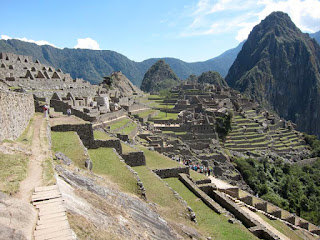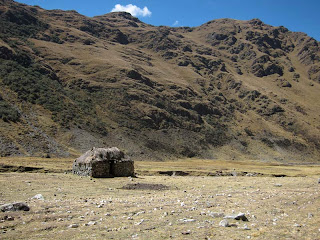I've just come back to Lima from a quick tour in central Cusco Department, Peru. Short on captions, here's a quick photo rundown of the trip. First, the obligatory photo from the ruins of Machu Picchu.
This lizard is very common on the ruins. Last year I narrowed it down to either Stenocercus ochoai or S. crassicaudatus, but I haven't nailed it down yet. Anyone out there know?
Down in the valley below the ruins.
An amazing leaf gall. Caused by a wasp or fly that lays its eggs on the leaf. The eggs secrete a chemical that the plant interprets as a hormone that makes it grow these "tumors" which proved shelter and food for the tiny larve.
My friend Michael Harvey thinks this tiny lizard is Proctoporus unsaacae, though he admits that may be an outdated name. Lizard taxonomy in the tropics is a knot proving very hard to untangle. There are many undescribed species out there to make it even more complicated.
I though this plant was most likely a Phyllanthus species.
Torrent Duck
White-capped Dipper
The highest ridge in the Urubamba Mountains, topped by Nevado Veronica at 19,100 feet.
The northern (Amazonian) slope has some nice cloud forest, home to many hummingbirds, such as this Purple-backed Thornbill.
A giant Fuchsia, surely a favorite plant for the Sword-billed Hummingbird.
A Red-and-white Antpitta that magically appeared in the only window into the bamboo understory that was visible from one spot in the middle of the paved road.
This is Denis, my client and birding companion for these 25 days. We're about to set out on a hike to a grove of Polylepis, starting at 14,200 feet. The distant ridge is only about 250 yards away and only 240 feet higher, but we took 45 minutes to get there.
The grove of Polylepis is visble here at the base of Nevado Veronica.
Here's looking back up at the base of the cliff and the grove where Royal Cinclodes is supposed to occur. It wasn't there during our visit, but we did see Giant Conebill, Ash-breasted Tit-Tyrant, White-browed Tit-Spinetail, and Stripe-headed Antpitta.
I took a lot of closeups of the fantastic dwarf plant life that occurs in this harsh climate.
One of the few shrubs offering food for hummingbirds here is this melastome, Brachyotum species.
Slender-billed Miner
Home sweet home for the llama herders.
Friday, July 30, 2010
Thursday, July 22, 2010
The Canopy Walkway at Explornapo Lodge, Peru
Here are a few photos from our morning on the canopy walkway 1.5 km into the forest from Explornapo Lodge. It's a great experience.
From this vantage point, you can get close-up views of canopy dwellers that normally have you straining your neck. Paradise, Green-and-gold, and Yellow-bellied Tanagers were at eye-level, and in the full sunlight were almost too colorful and bright to look at.
Gray-headed Kite, harvesting a twig for nesting material.
White-fronted Nunbirds were sounding the alarm when the kite arrived.
Our best views ever of a Yellow-margined Flycatcher, whose call notes here are almost like a screaming raptor.
In the afternoon we returned to some river islands in the Napo, just upriver from the lodge. I flushed this Helicopis gnidus metalmark, following it until it landed on the underside of a leaf, typical of many butterflies in this family. This genus apparently has only three species; the only other one I've seen was H. cupido, and it was also on an Amazonian river island, just off of Manaus. So it seems that this genus uses some plant as a larval food found only on such islands.
From this vantage point, you can get close-up views of canopy dwellers that normally have you straining your neck. Paradise, Green-and-gold, and Yellow-bellied Tanagers were at eye-level, and in the full sunlight were almost too colorful and bright to look at.
Gray-headed Kite, harvesting a twig for nesting material.
White-fronted Nunbirds were sounding the alarm when the kite arrived.
Our best views ever of a Yellow-margined Flycatcher, whose call notes here are almost like a screaming raptor.
In the afternoon we returned to some river islands in the Napo, just upriver from the lodge. I flushed this Helicopis gnidus metalmark, following it until it landed on the underside of a leaf, typical of many butterflies in this family. This genus apparently has only three species; the only other one I've seen was H. cupido, and it was also on an Amazonian river island, just off of Manaus. So it seems that this genus uses some plant as a larval food found only on such islands.
Monday, July 19, 2010
A Handsome Woodpecker
This handsome Chestnut Woodpecker was digging away in this rotten fallen branch just behind our cabin here at Explornapo Lodge, Peru this afternoon. I was about 20 feet from it before I realized it was there, and it paid me no heed. There must have been some tasty morsels in that wood.
Our foray this morning to the river islands in the Napo River nearby were successful. Very quickly we had looks at Parker's and White-bellied Spinetails, Lesser Wagtail-Tyrant, Lesser Hornero, Black-and-white Antbird, and Riverside Tyrant. Wintering Blue-and-white Swallows and a Large Elaenia (from their breeding grounds in southern South America) added to the morning's interesting finds.
Our foray this morning to the river islands in the Napo River nearby were successful. Very quickly we had looks at Parker's and White-bellied Spinetails, Lesser Wagtail-Tyrant, Lesser Hornero, Black-and-white Antbird, and Riverside Tyrant. Wintering Blue-and-white Swallows and a Large Elaenia (from their breeding grounds in southern South America) added to the morning's interesting finds.
Sunday, July 18, 2010
Olive-spotted Hummingbird: Jewel of the Amazon
Well, the title of this short post is a bit of an exaggeration.
As you can see, Olive-spotted Hummingbird is not a very flashy member of the second most diverse family of birds in the world. Most birds with the word "olive" in their names aren't. Despite that, this was one of the highlights of this morning's birding on Yanamono Island, a major river island in the Amazon River opposite Explorama Lodge. There are a number of birds known only or primarily from such islands, and this hummer is one of them. The ranges of these birds, among which we also saw Zimmer's Woodcreeper, Red-and-white Spinetail, and Plain-breasted Piculet, appear not as amorphous blobs of color on the maps in your field guide, but rather are long squiggles that follow the Amazon and its major drainages, such as the Ucayali, Napo, and Madeira. If you haven't been to these areas, you haven't seen these birds.
This afternoon we rode the fast boat down the Amazon to its junction with the Napo, then went up that river to ExplorNapo lodge (and the ACTS field station) for the next five nights. Tomorrow we'll bird another island near here, looking for more specialties such as Parker's Spinetail and Riverside Tyrant.
Here we are about to board our boat from Yanamono Island. It's been overcast and cool from an unusually strong cold front. The low this morning was 62°F, the high only 68° today, close to an all-time record low for the normally steamy heart of the Amazon Basin.
As you can see, Olive-spotted Hummingbird is not a very flashy member of the second most diverse family of birds in the world. Most birds with the word "olive" in their names aren't. Despite that, this was one of the highlights of this morning's birding on Yanamono Island, a major river island in the Amazon River opposite Explorama Lodge. There are a number of birds known only or primarily from such islands, and this hummer is one of them. The ranges of these birds, among which we also saw Zimmer's Woodcreeper, Red-and-white Spinetail, and Plain-breasted Piculet, appear not as amorphous blobs of color on the maps in your field guide, but rather are long squiggles that follow the Amazon and its major drainages, such as the Ucayali, Napo, and Madeira. If you haven't been to these areas, you haven't seen these birds.
This afternoon we rode the fast boat down the Amazon to its junction with the Napo, then went up that river to ExplorNapo lodge (and the ACTS field station) for the next five nights. Tomorrow we'll bird another island near here, looking for more specialties such as Parker's Spinetail and Riverside Tyrant.
Here we are about to board our boat from Yanamono Island. It's been overcast and cool from an unusually strong cold front. The low this morning was 62°F, the high only 68° today, close to an all-time record low for the normally steamy heart of the Amazon Basin.
Labels:
Olive-spotted Hummingbird,
Yanamono Island
Subscribe to:
Posts (Atom)







































